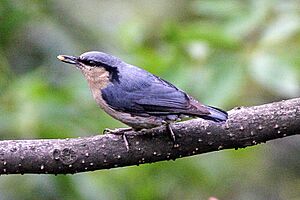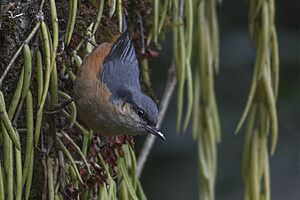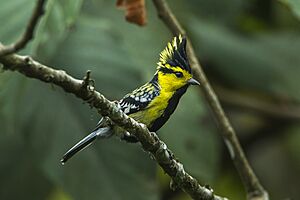Chestnut-vented nuthatch facts for kids
Quick facts for kids Chestnut-vented nuthatch |
|
|---|---|
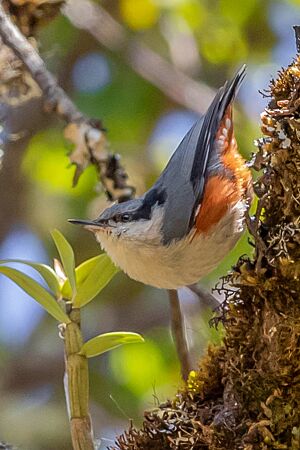 |
|
| This nuthatch in Myanmar is of the S. n. nagaensis type. | |
| Conservation status | |
| Scientific classification | |
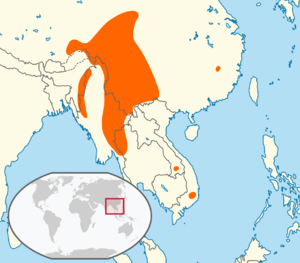 |
|
| Where the chestnut-vented nuthatch lives | |
| Synonyms | |
|
The chestnut-vented nuthatch (Sitta nagaensis) is a type of bird in the nuthatch family. It is a medium-sized bird, about 12.5–14 cm (4.9–5.5 in) long. Its back and head are a solid gray-blue. It has a clear black stripe near its eyes.
The bird's belly is gray to buff, with brick-red sides. Its undertail feathers are white with a reddish edge. This nuthatch makes different sounds, sometimes like an alarm. Its song is a simple, repeating crackle, often sounding like chichichichi.
We don't know much about what it eats, but it probably likes small arthropods (like insects) and seeds. The breeding season for these birds starts between March and May. They usually build their nests in tree holes. A female nuthatch lays two to five eggs.
Chestnut-vented nuthatches live in northeast India, parts of Tibet, and south-central China. They also live in eastern Myanmar and northwestern Thailand. Some groups are found in southern Laos and Vietnam. They mostly live in evergreen forests or pine forests. They can also be found in mixed or deciduous forests.
These birds prefer warm, wet lowland forests and montane forests (mountain forests). They live at different heights, from 915–4,570 m (3,002–14,993 ft) above sea level. The British naturalist Henry Haversham Godwin-Austen first described this bird in 1874. He named it Sitta nagaensis after the Naga Hills, where he found it.
This nuthatch is part of a group of species that includes the Kashmir nuthatch and the Eurasian nuthatch. All these birds build mud around their nest entrances. We don't know exactly how many chestnut-vented nuthatches there are, but their numbers seem to be going down. However, they live in a wide area. Because of this, the International Union for the Conservation of Nature says they are of least concern, meaning they are not in immediate danger.
Contents
About the Chestnut-vented Nuthatch
The chestnut-vented nuthatch was first described in 1874 by Henry Haversham Godwin-Austen. Its scientific name, Sitta nagaensis, comes from "naga" and a Latin word meaning "lives in." This refers to the Naga Hills where the first bird was found.
Scientists have studied the DNA of nuthatches to understand how they are related. The chestnut-vented nuthatch is closely related to the Eurasian nuthatch and the Kashmir nuthatch.
{{clade gallery |width=375px; |height=400px; |main-caption=How the Chestnut-vented Nuthatch is related to other nuthatches |footer1=Nuthatch relationships according to Pasquet, et al. (2014). |cladogram1=
|
||||||||||||||||||||||||||||||||||
|footer2=Nuthatch relationships according to Päckert et al. (2020). |cladogram2=
|
|||||||||||||||||||||||||||||||||||||||||||||||||||||||||||||
Types of Chestnut-vented Nuthatches
There are three recognized types (subspecies) of the chestnut-vented nuthatch:
- S. n. montium was described in 1899. It lives in eastern Tibet, southern and eastern China, Myanmar, and northwest Thailand.
- S. n. nagaensis was described in 1874. It lives in northeast India and western Myanmar.
- S. n. grisiventris was described in 1920. It lives in southwest Myanmar and southern Laos and Vietnam.
What the Bird Looks Like
The chestnut-vented nuthatch is a medium-sized bird, about 12.5–14 cm (4.9–5.5 in) long. Its back and head are a solid blue-gray, from its crown (top of the head) to its tail. It has a clear black line near its eyes that goes to the base of its wing.
The bird's belly is pale gray, sometimes with a buff (yellowish-brown) tint. The dark, brick-red sides of its body stand out against the rest of its belly. The feathers under its tail have a large white edge or a white spot near the tip.
Male and female chestnut-vented nuthatches look very similar. The male's sides are a deep brick-red. The female's sides are more reddish-brown and match the color of her undertail feathers. Young birds are more buff than adults.
Their eyes are brown, and their bill is grayish-black. Their legs are dark brown, greenish, or blue-gray.
The different types of nuthatches have slight color changes. Birds in China (S. n. montium) have buff bellies. As you go south, the bellies become duller and grayer.
Similar Birds
The chestnut-vented nuthatch lives in some of the same areas as the Burmese nuthatch. However, you can tell them apart by the color of their bellies. The Burmese nuthatch has white cheeks and throat that stand out from its reddish-brown belly. The chestnut-vented nuthatch does not have this strong contrast.
Sometimes, young Burmese nuthatches or females can look similar to chestnut-vented nuthatches. But the chestnut-vented nuthatch has darker, duller blue upperparts. It also has red sides that contrast with its buff belly. Its undertail feathers have a "scales" pattern from red edges, while the Burmese nuthatch's undertail is almost all white.
In southwest China, the chestnut-vented nuthatch lives near the Yunnan nuthatch. The Yunnan nuthatch is smaller and has a thin white line above its eye. Its belly is plain and pale buff, without any reddish color on its sides.
The white-tailed nuthatch also lives in similar places in India and Myanmar. But the white-tailed nuthatch has a white spot on its tail feathers. It also has more orange on its belly, without the brick-red sides or white spots under the tail.
The giant nuthatch is much larger than the chestnut-vented nuthatch. It has a thinner eye stripe and a lighter cap (top of the head) than the rest of its back.
Life and Habits
The chestnut-vented nuthatch usually looks for food alone or in pairs. Outside of the breeding season, they might join groups of different bird species. In winter, you might see them with tits like the yellow-cheeked tit, woodpeckers, and other small birds.
Sounds and Calls
The chestnut-vented nuthatch makes many different sounds. They have squeaky sit or sit-sit calls. They also make drier tchip or tchit sounds, which can sound like the alarm of a winter wren. Their alarm calls are described as nasal sounds like quir or mew. They also make a sharp, metallic tsit sound.
Their song is a simple, repeating rattle or tremolo, like chichichichichi... or trr-rrrrrrr-ri.... It usually lasts less than a second. Sometimes it slows down to chi-chi-chi-chi-chi... or diu-diu-diu- diu-diu, which sounds a bit like the Eurasian nuthatch's song.
What They Eat
The chestnut-vented nuthatch often looks for food on the ground, on rocks, old tree stumps, or on trees. We don't have exact details about their diet. However, they likely eat small arthropods (like insects and spiders) and seeds.
Reproduction and Life Cycle
The breeding season for these birds changes depending on the region. In Thailand, it's from March to May. In India, it's March to June. In eastern Myanmar, it's April to early June. In China, it's April to May.
They start building their nests in January in places like Thailand and Vietnam. The nest is usually about 10 m (390 in) high in a tree hole or a stump.
Like other nuthatches, the chestnut-vented nuthatch might use mud to make the nest entrance smaller. This helps protect their eggs and young from predators. They line the bottom of the nest with bark pieces and moss, then add hair.
They lay two to five eggs. The eggs are white with red dots and reddish-purple spots. These spots are mostly at the wider end of the egg.
Where They Live
The chestnut-vented nuthatch lives from Tibet all the way to southern Vietnam. In India, you can find it in the eastern states of Arunachal Pradesh, Nagaland, Manipur, Assam, and Meghalaya.
They live in the Chin Hills of western Myanmar. Most of them live in the eastern part of Myanmar, from Kachin State to Shan State, and into western Thailand. They also nest in Tibet and south-central China, including Sichuan and Yunnan. A small group lives in northwestern Fujian, China, on Mount Huanggang.
There are two other groups of these birds that live far from the main population. One is in southern Vietnam on the Đà Lạt Plateau. The other is in Laos on the Bolaven Plateau.
These nuthatches usually live in evergreen forests in the mountains. They can also be found in pine forests on dry ridges within evergreen forests. In some areas, they live in deciduous forests (where trees lose their leaves). They can be found in oak forests, alder groves, spruce forests, fir forests, and even among rhododendron plants. In Sichuan, they live in poplar and walnut forests.
They live at different heights above sea level. In India, Thailand, and Myanmar, they are found from 1,400–2,600 m (4,600–8,500 ft), sometimes up to 3,200 m (10,500 ft). In Tibet and Sichuan, they live from 1,050–3,500 m (3,440–11,480 ft), and up to 4,570 m (14,990 ft) in Yunnan. The birds in southern Vietnam live between 915–2,285 m (3,002–7,497 ft).
Status and Dangers
The number of chestnut-vented nuthatches is going down. This is because their homes are being destroyed and broken into smaller pieces. However, they live in a very large area, estimated to be 3.8 million km2 (1.5 million square miles). They are generally common in the places they live.
Because of their wide range, the International Union for the Conservation of Nature considers the chestnut-vented nuthatch to be of least concern. This means they are not currently at high risk of disappearing.
A study in 2009 looked at how climate change might affect nuthatches in Asia. It predicted that the chestnut-vented nuthatch's living area could shrink by 15.9 to 17.4% between 2040 and 2069.



